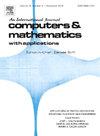考虑亚音速可压缩湍流条件的迷宫式密封装置拓扑优化设计
IF 2.9
2区 数学
Q1 MATHEMATICS, APPLIED
引用次数: 0
摘要
本研究提出了一种拓扑优化模型,用于设计在考虑湍流可压缩流的情况下以多种相对速度运行的设备。该模型由轴对称域中的法夫尔平均纳维-斯托克斯方程和连续边界传播模型组成。例如,与旋转轴接触的固体材料将具有旋转速度,而包覆在支架上的材料将具有零绝对速度。该方法由一个分离式求解器组成,其步骤包括 FANS 方程、k-ϵ 湍流方程和传播模型。灵敏度通过邻接法自动微分获得,内部点优化器用于更新设计变量。通过使用三种不同的目标函数(径向速度最大化、静压变化率最大化和涡度最大化)定义了一个迷宫密封研究案例,以说明该方法。结果是在实际运行条件下对小型迷宫密封进行的设计。本文章由计算机程序翻译,如有差异,请以英文原文为准。
Topology optimization design of labyrinth seal-type devices considering subsonic compressible turbulent flow conditions
In this work, a topology optimization model for designing devices that operate with multiple relative velocities considering turbulent compressible flows is proposed. The model consists of the Favre-averaged Navier-stokes equations in an axisymmetric domain coupled with a continuous boundary propagation model. The propagation is used to impose different solid behaviors based on which wall it is connected to, for example, solid material in contact with a rotating shaft will have a rotational velocity, while material encrusted in the support will have zero absolute velocity. The implementation is composed of a segregated solver with steps for the FANS equations, the turbulent equations, and the propagation model. The sensitivity is obtained with automatic differentiation of the adjoint method and an internal point optimizer is used to update the design variable. A study case of a labyrinth seal is defined to illustrate the methodology by using three different objective functions, maximization of radial velocity, static pressure change rate, and vorticity. The results are designs for small-scale labyrinth seals in real operation conditions.
求助全文
通过发布文献求助,成功后即可免费获取论文全文。
去求助
来源期刊

Computers & Mathematics with Applications
工程技术-计算机:跨学科应用
CiteScore
5.10
自引率
10.30%
发文量
396
审稿时长
9.9 weeks
期刊介绍:
Computers & Mathematics with Applications provides a medium of exchange for those engaged in fields contributing to building successful simulations for science and engineering using Partial Differential Equations (PDEs).
 求助内容:
求助内容: 应助结果提醒方式:
应助结果提醒方式:


